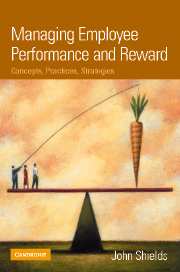Book contents
- Frontmatter
- Contents
- List of figures and tables
- Foreword by John Egan
- Acknowledgements
- Introduction: Setting the scene
- Part 1 The fundamentals
- Part 2 Performance management in action
- Part 3 Base pay and benefits
- Part 4 Rewarding employee performance
- 14 Overview of performance-related rewards
- 15 Merit pay for individual performance
- 16 Recognition awards
- 17 Results-based individual incentives
- 18 Collective short-term incentives
- 19 Collective long-term incentives
- 20 Executive incentives
- Case study. Beyond the hard sell: Performance incentives at Southbank
- Part 5 Fitting it all together
- Model responses to case studies
- References
- Index
Case study. Beyond the hard sell: Performance incentives at Southbank
from Part 4 - Rewarding employee performance
- Frontmatter
- Contents
- List of figures and tables
- Foreword by John Egan
- Acknowledgements
- Introduction: Setting the scene
- Part 1 The fundamentals
- Part 2 Performance management in action
- Part 3 Base pay and benefits
- Part 4 Rewarding employee performance
- 14 Overview of performance-related rewards
- 15 Merit pay for individual performance
- 16 Recognition awards
- 17 Results-based individual incentives
- 18 Collective short-term incentives
- 19 Collective long-term incentives
- 20 Executive incentives
- Case study. Beyond the hard sell: Performance incentives at Southbank
- Part 5 Fitting it all together
- Model responses to case studies
- References
- Index
Summary
Three weeks into her new job as director of human resources at Southbank and things have yet to start looking up for 30-something high-flyer Alison Lee. The enormity of the challenge she faces in redesigning performance-related rewards for the 8,000 staff and 400 remaining branches in Southbank's nation-wide retail division seems to loom larger by the day. Since her appointment, Alison has held daily crisis talks with her new boss – and the bank's new CEO – James Allright, about the public relations and reward management shambles in the retail division and how it can be addressed.
The challenge they face is enormous. Staff morale has plummeted, reward satisfaction is at an all-time low, the Financial Services Union is planning to make performance pay a key issue in the next round of enterprise agreement negotiations, ten employees have been charged with fraud, customers are deserting in droves, investors have dumped Southbank shares, and the National Consumer Affairs Commission has launched an investigation into allegations of unethical sales practices in the bank's branches. At the heart of these problems lies the Sales Incentive Scheme (SIS) introduced two and a half years ago amid much fanfare by Alison's predecessor, Graham Starbuck.
The culture of selling
Under its previous CEO Jonathan Rockwell, Southbank pursued aggressive market expansion in the highly competitive field of retail banking, especially in personal loans, housing loans, credit card business and business loans.
- Type
- Chapter
- Information
- Managing Employee Performance and RewardConcepts, Practices, Strategies, pp. 501 - 506Publisher: Cambridge University PressPrint publication year: 2007

